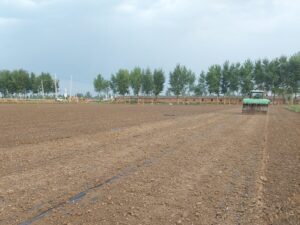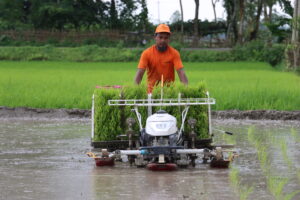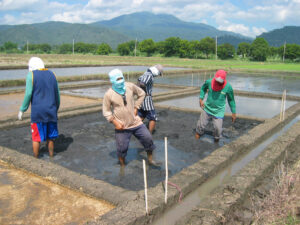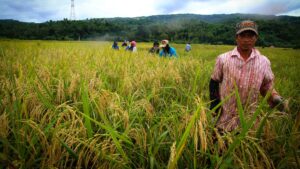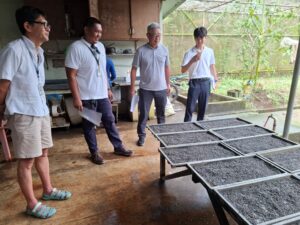Sharif Ahmed, Manik Debnath, and Humnath Bhandari
Did you know that over 40 million people in coastal Bangladesh, particularly those residing in the lower Ganges Delta, face difficult farming conditions? Many of their lands suffer from soil salinity, which makes crop cultivation challenging. Farmers primarily grow rice during the rainy season and often leave their fields vacant during the dry season. The combination of recurring cyclones, soil salinity, unpredictable rainfall, drainage issues, and limited access to freshwater significantly hinders productivity and negatively impacts farmers’ livelihoods.
To address these challenges, it is crucial to develop a strategic blend of technological innovations and supportive policy actions. Tackling key issues such as water scarcity, poor drainage, climate extremes, and soil degradation is essential for improving agricultural productivity and resilience.
Understanding the major challenges facing sustainable agriculture
Impact of Soil and Water Salinity on Crop Production
Salinity is a major constraint to agriculture in the coastal belt of Bangladesh. More than 1.2 million hectares of arable land are saline-affected, with 0.27 million hectares recording 4.1–8.0 dS/m and 0.35 million hectares exceeding 8.1 dS/m. These levels surpass crop tolerance thresholds. Rising sea levels, reduced freshwater inflow, and storm surges increase salinity intrusion, affecting groundwater and surface water sources. In some districts, 35% of farmland remains fallow during the Rabi season due to salinity and lack of irrigation. Even monsoon floods leave behind salt residues, cutting Aman yields by 10–25% or more.


High Rainfall Variability During the Monsoons
Rainfall variability during the monsoon season disrupts Aman rice farming, delaying transplanting as farmers wait for floods to recede. Seedbeds and young seedlings are often lost to unexpected inundation. This affects Rabi crop timelines, reducing opportunities to grow wheat, pulses, vegetables, or oilseeds. Late rains and waterlogging can destroy Rabi crops. Excess rain also damages standing Aman rice, and inadequate drainage systems compound these problems. Many farmers switch to shrimp cultivation or leave land fallow, hampering crop diversification.

Waterlogging and Inadequate Drainage Infrastructure
Large areas in coastal zones face seasonal flooding from monsoon rains and tidal surges, leading to prolonged waterlogging. This is worsened by silted rivers, low soil infiltration, shallow water tables, and poorly maintained drainage systems. Both natural and human-made factors contribute to poor drainage. Illegal canal blockages, often for fishing or by misuse of authority, further restrict water flow, harming ecosystems, disrupting farming, and threatening local livelihoods.

Freshwater Scarcity in the Dry Season and Its Implications
Coastal Bangladesh experiences acute freshwater shortages during the dry season due to salinity intrusion, scarce surface water, and degraded groundwater. The low-lying terrain leads to brackish river water, unsuitable for irrigation or drinking. With limited surface sources, communities rely heavily on aquifers, but even shallow wells are increasingly saline. Though deep wells offer some relief, overuse risks ecological imbalance, as saline water from lower layers can contaminate the fresh supply.
Socio-economic and Ecological Barriers to Sustainable Agriculture
Farming in coastal Bangladesh faces complex socio-economic and ecological challenges. Frequent disasters like cyclones, floods, salinity, and dry-season water shortages create uncertainty in crop yields, discouraging investment in agriculture. Many farmers turn to NGO relief, fostering dependency instead of long-term sustainability. Fishing is often preferred over farming due to lower risks. Heavy clay soils make cultivation harder, while traditional norms limit women’s participation, reducing the labor force. Additionally, slow adoption of new technologies hampers efforts to overcome these issues.
Strategies for Sustainable Farming in Coastal Bangladesh
Transforming agriculture in Bangladesh’s coastal zones into a sustainable and productive system requires strategic technological innovations and supportive policy actions. Below are some actionable items that can be taken to improve sustainability:
Enhance Freshwater Availability in the Dry Season
Freshwater scarcity during the dry season poses a significant challenge for coastal agriculture, as many rivers and canals become saline due to tidal saltwater intrusion. Key interventions to address this issue include:
- Strengthening the management of rivers and canals by maintaining them and installing controlled sluice gates to prevent the intrusion of saline water.
- Promoting community-based water management systems that focus on field-centric planning to ensure equitable water distribution and usage.
- Harvesting and storing rainwater during the wet season in reservoirs and canals for use during the dry months.
- Reducing dependency on groundwater extraction to lower the risk of increasing salinity in aquifers.
If these efforts are implemented collaboratively by local communities and policymakers, they will help stabilize water availability and support year-round cropping.
Optimize the Aman Rice Cropping Window
Farmers traditionally grow long-duration Aman rice to adapt to flood-prone conditions. However, this often delays the planting of dry-season crops, which limits overall yields and diversification. To address these challenges, several strategies can be implemented:
- Promote short- and medium-duration Aman rice varieties that enable earlier harvests without compromising yield.
- Encourage community-based, synchronized late transplanting of short-duration varieties to mitigate flood damage and align harvests with the optimal sowing window for Rabi crops in November.
- Support this transition through field demonstrations and farmer training to alleviate concerns about bird damage or wet field conditions during early harvests.

Photo:
Diversify Dry Season (Rabi) Crops
Due to water constraints, many large areas of coastal farmland remain unused during the dry season. However, with modest irrigation, these lands have significant potential for diversified cropping. The recommended actions are as follows:
- Introduce and promote profitable Rabi crops, such as maize, groundnut, sunflower, mustard, and mung bean, which require less irrigation.
- Provide support for timely sowing and irrigation to maximize yields and reduce risks associated with residual salinity.
- Develop cropping strategies that effectively utilize fallow lands, enhancing food security, increasing farmer income, and contributing to the national GDP.

Promote Homestead-Based Mixed Farming
Homestead farming provides an effective alternative to traditional agriculture in coastal areas where salinity, flooding, and freshwater scarcity impede crop production. These coastal homesteads are typically larger and often feature ponds, livestock, and available land that can be utilized for integrated farming systems, enhancing both food security and income.
- Encourage year-round production of vegetables, fruits, fish, and poultry to promote integrated homestead-based farming systems.
- Use small-scale agricultural machinery, such as fodder choppers, mini rice husking mills, maize shellers, and oil extractors, to add value to produce and reduce labor intensity.
- Pond embankments and marginal lands should be utilized to cultivate multipurpose trees such as elephant apple, jujube, and moringa, along with vine vegetables.
- Support women’s economic participation is crucial, particularly by encouraging their involvement in backyard farming, small-scale agro-processing, and creating market linkages.
Overall, homestead farming can serve as a key pathway to diversify diets, enhance household resilience, and decrease dependence on external food sources.

Scale Up Climate-Smart Production Systems
Adapting climate-smart technologies is crucial to help coastal farmers cope with increasing weather and soil-related risks. Recommended technologies include:
- Introduce climate-resilient crop varieties such as submergence-tolerant Aman rice and drought-tolerant Rabi crops.
- Implement sorjan systems (raised beds and trenches) to simultaneously cultivate crops and fish in saline or waterlogged fields.
- Promote conservation agriculture practices like dibbling, zero tillage, and mulching to retain soil moisture, reduce erosion, and enhance organic matter.
- Expand dry-direct-seeded Aus rice (DSR) systems in pre-monsoon seasons to reduce water usage and labor costs where puddling is difficult.

Restore Soil Health and Fertility
Coastal soils are often nutrient-depleted due to prolonged monocropping and high salinity. Therefore, managing organic matter is crucial for restoring soil fertility. Potential restorative measures include:
- Crop diversify by introducing legumes such as mung beans to promote nitrogen fixation.
- Incorporate green manure crops. Using crops like Dhancha (Sesbania) and Sunnhemp to enhance organic content and improve soil structure.
- Retain and incorporate crop residues. This practice aids in better moisture retention and nutrient cycling.
- Apply compost and vermicompost, which can help rebuild soil fertility and enhance productivity over time.
Policy Recommendations for Transforming Coastal Agriculture
To support sustainable agriculture in coastal Bangladesh, policy actions should focus on increasing the availability of surface water, optimizing crop calendars, encouraging diversification, and scaling up climate-resilient innovations. Interventions include:
- Improved water management. Install and maintain controlled sluice gates, excavate and repair canals, and implement community-based water-sharing systems. Encourage rainwater harvesting during the wet season to boost water availability in the dry months.
- Optimize crop calendars. Promote synchronized planting of short- and medium-duration Aman rice varieties to reduce flood risks and enable timely sowing of Rabi crops.
- Support crop diversification. Encourage the cultivation of Rabi crops like maize, groundnut, mung beans, and sunflowers, which are better suited to coastal conditions and can enhance productivity and farmer incomes.
- Scale up climate-resilient innovations. Prioritize the adoption of stress-tolerant crop varieties, the sorjan production system, and conservation agriculture practices such as zero tillage and mulching.
- Promote inclusive development. Strengthen homestead farming, particularly among women, and ensure that new technologies and practices are accessible and scalable across farming communities.
Transforming Bangladesh’s coastal agriculture requires more than innovation and advanced technologies. It needs a multifaceted approach connecting science with grassroots engagements. Integrated and sustained actions such as supportive policies, coordinated implementation, and community participation can help enhance food security, resilience, and farmer incomes in the region.

